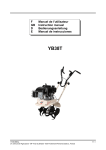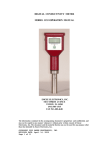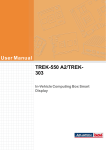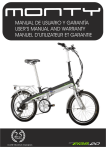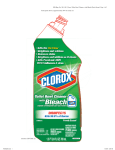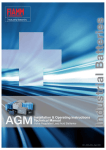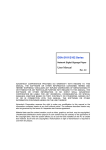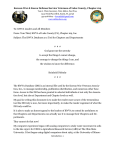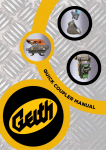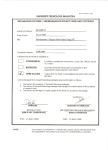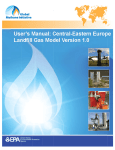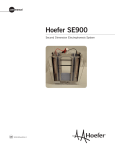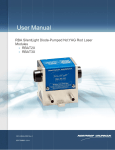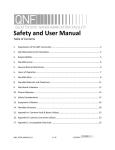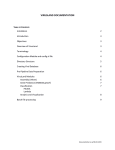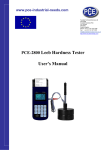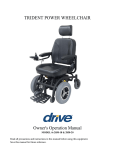Download Cleanroom User Manual - Nanofabrication Cleanroom Facility
Transcript
University of North Texas Nanofabrication Facility 1 EMERGENCY CONTACTS Primary Emergency Contact: 911 Poison Control Center:800-222-1222 For Non-Emergency Chemical Situations: Department of Risk Management (DRM): 940‐369‐2123 If Time Permits, Contact the Cleanroom Staff: Dr. Jianchao (J.C.) Li: 940-369-5318 \ 2 Emergency Response Checklist IF A TOXIC GAS LEAK OCCURS 1. Push a Yellow “Gas Off” button 2. Evacuate the building immediately 3. Alert others on the way out 4. Meet outside in parking lot 1 at Discovery Park IF YOU HEAR THE FIRE ALARM 1. Evacuate the building immediately 2. Alert others on the way out 3. Meet outside in parking lot 1 at Discovery Park IF YOU SEE SOMEONE UNDER THE EMERGENCY SHOWER OR EYE WASH 1. If the victim is by themselves, stay close to assist. 2. Call 911 and demand an ambulance. 3. If requested, assist the person in removing contaminated clothing being careful not to become contaminated. 4. Advise person to stay in shower 5 minutes for HF contamination, 15 minutes for all other chemicals. 5. If the chemical is Hydrofluoric Acid (HF) assist the victim in applying Calgonate (calcium gluconate) while wearing clean gloves. 6. Get the MSDS sheet (E151) and hand it to the Emergency Response Team or fire department. 7. Notify a staff member. IF YOU GET CHEMICALS ON YOUR SKIN 1. Approach the nearest emergency shower or eye wash and pull the handle to activate. 2. Demand help but remain under the emergency shower or eye wash. IF A FIRE STARTS 1. Pull fire alarm located at emergency exit doors. 2. Evacuate the building immediately. 3. Alert others on the way out. 4. Meet outside in parking lot 1 at Discovery Park 3 TABLE OF CONTENTS I. Policies & Procedures 5 II. Cleanroom Gowning Procedure III. Cleanroom Etiquette 6 8 IV. Cleanroom Emergency Equipment & Locations 11 V. Personal Protection Equipment VI. Chemical Use 14 16 VII. Special Chemical Hazards 18 VIII. Spill Response Procedures 19 IX. Nanofabrication Cleanroom Emergency Exits X. References 25 4 25 Policies & Procedures Highlights & specific issues: Hood, gown, booties w/shoe covers, masks, gloves, and safety eyewear. Bouffant caps are required for long hair. Keep all hair and ears covered with hood or cap. Never open your gown in the cleanroom. Never touch your skin with your gloves. If you do, put on clean gloves immediately. Only authorized users may enter the cleanroom unescorted. The buddy system must ALWAYS be used in the cleanroom. Visitors must be escorted by a cleanroom qualified faculty/staff member. Visitors must sign in/out in the visitor log. No food or drink is permitted in the cleanroom. No corrugated cardboard, styrofoam, foam rubber or non-cleanroom paper is permitted in the cleanroom. No pencil, erasers or retractable pens are permitted in the cleanroom. Be considerate by cleaning up your own mess, not messing up someone else's work, letting the staff know when new supplies are needed, etc. Ask for permission before bringing anything in or taking anything out of the cleanroom. DO NOT modify equipment without the approval of the Cleanroom Staff. IF YOU AREN’T SURE HOW IT WORKS, ASK BEFORE YOU USE IT! Follow the Cleanroom Safety Guidelines. 1) Wafer Handling [2] A. NEVER sneeze, cough, or spit toward your wafers even with a mask. Resulting spots are nonremovable. B. Never speak towards your wafer. C. Avoid passing anything over your wafer which may release particles D. Whenever possible, store wafers in covered containers. 2) Tools and Repairs A. Vacuum or blow clean all equipment followed by an Isopropyl alcohol wipe before taking it into the cleanroom. No equipment will be modified without prior approval of the Cleanroom Staff. No new equipment will be moved into the cleanroom without prior approval of the cleanroom manager. B. Keep parts and tools at the workstation as clean and orderly as possible. Use toolboxes where possible. C. Any work or tools dropped on the floor shall be considered contaminated, and must be cleaned. D. Never leave exposed critical parts on the workbench. 5 E. Work on a clean surface. 3) Good Mannerss and Good d Sense A. Obey signs on equ uipment or in n specific arreas. B. Refill squirt bottlees that you find fi empty. C. Let em mpty solventt jugs evaporrate dry. Rin nse acid and solvent jugss three timess with tap waater before pllacing in cartt next to cleaanroom officce. D. When n working wiith acids or solvents, s weaar chemical resistant nitrrilite/neopreene gloves availablee in the storage room. Beefore using th he gloves, be sure they aare in good sshape. Replaace them if th hey are not. F. When disposing of acid mixtu ures, dilute with w lots of w water. G. Label all mixturess with Chem mical Safety Warning W Sheeets availablle in a buckeet in the hallw way. Clean nroom Gowniing Proceduree The dirtieest thing in our o cleanroo om will be th he people whho use it. Coonsequently, all cleanrooom users mu ust wear cleanroom garm ments which trap t and holdd the particles emitted bby their bodiees and cloth hing [2]. A. Put on n shoe coverrs located insside at the entrance of the gown ning room. Only O flat or very low-heeled shoees may be worn. No sandals or o open-toed shoes. ully put on a hood and cap. The hood d must comppletely coverr B. Carefu your hairr and ears. In n addition, th he bouffant cap c is requirred for peoplle with long g hair. It sho ould be worn n under the hood. h Bouffantt cap Hood and a face massk C. Remove your cleaanroom garm ment from ge cabinet an nd inspect. The T the storag permanen nt gowns aree stored on assigned a han ngers in storage cabinets c in th he cleanroom m gowning arrea. Take caare to keep thhe garment completeely off of thee floor at all times. Inspeect your garm ment each tim me you wear it fo or tears or so oiling. n your cleanrroom gown. First, step in nto the D. Put on 6 gown leg gs, taking carre not to let the t garment touch the ground at any time. Then T pull on n the upper half h of the goown and zip it all of the way up. While W weariing a hood, be b sure the “skirt” of the hood is com mpletely inside thee collar of th he jumpsuit. E. Put on n booties. To o put on cleanroom m booties, siit on the gowning bench. Be sure s the top of o the boot is over the bottom b of thee jumpsuit hat any particcles falling down d the leg so th gown leg g will be trap pped in the bootie. b F. Put on n Cleanroom m Gloves. Carrefully put on th he first glove, touching th he outside of o this glove as little as possible. p Put on the seconnd glove usiing the previously gloved d hand, takin ng care not to touch yourr skin with tthe gloved hand. Pull the cuff off the gloves over the sleeeve of the juumpsuit so thhat any particles falling from m your sleevees are trappeed in the glovve. Gloves shhould be worn at all a times, no bare hands or o fingers. 7 Cleanroom Etiquette [2] I. Disposal of Damaged or Non-Functional Equipment Whenever something quits working, please give it to a member of the cleanroom staff, who will then either repair it or decide if it needs to be disposed of. Lab equipment is inherently expensive, and eventually much of the cost is passed on to the users. Therefore it helps everybody when we can avoid buying new equipment needlessly. II. Broken and Uncleanable Glassware, Broken Wafers, Razors, and Other Sharp Objects With all the glassware used in the cleanroom, obviously breakage will occur, or things will get contaminated beyond the point of being cleanable. If you find glassware meeting this description, please be sure to throw it into the container marked “Sharp Objects Only”. This also applies to the following materials: wafers, razor blades, needles, microscope slides and cover slips, and anything else that is questionable. III. How to Make the Laundry Guy Happy This one’s simple, but it really speeds up that painfully slow and boring job of doing the laundry. When you are finished with your gown, before you put it into the dirty clothes can, please zip it up and make sure it is not inside out. Also, please unfasten the booties from the gown and each other. IV. Labeling Things When You Cannot Stick Around to Watch Them Frequently, cleanroom users will need to leave things under the fume hoods overnight or for part of the day unattended. Our policy here is simple: Anything left unattended must be labeled with your NAME, PHONE NUMBER WHERE YOU CAN BE REACHED (not the number of any front office), WHAT IT IS THAT IS SITTING THERE, and the DATES AND TIME of when you left it AND when you will return to get it. All this can be filled out on the Chemical Label Forms provided inside the cleanroom. If you do not use this form, your chemical(s) will be disposed of immediately 8 V. Disp posal of Solvent-and Photoresis P t-Soaked M Materials We have several red trash cans in n the cleanro oom built speecifically for the disposaal of solventtsoaked materials, m and d require thaat they be useed for the diisposal of alll such materials. While iit may seem m like a coup ple of TexW Wipes with ph hotoresist onn them is nott that bad, juust rememberr that the air in n the cleanroo om is constaantly recircullated, so all those vaporss will find thheir way bacck in eventuallly for everyo one to breath he. The follo owing materiials should bbe put in the solvent canss: ohols (ethano ol, methanol, isopropano ol, etc.) Any alco Acetone TCE (Triichloroethyleene) Chlorobeenzene (this stuff is partiicularly dang gerous) Photoresist and relateed products VI. What If I Do not n Know How H to Usse Somethiing, or If Itt Malfuncttions Whilee I ng It? am Usin If you neeed to use a particular p pieece of equipment and yoou are not abbsolutely surre how to usee it, first of alll, DO NOT TRY TO LE EARN BY DOING D IT!! ! The staff iss here to hellp you, and tthey can pointt you to the right r person to show you u how to do it. If somethhing breaks dduring a proccess, tell the sttaff and they y will take caare of it. Abo ove all, pleasse DO NOT T try to fix soomething on your own!! VII. Wh hat Are Th he Procedurres For Cleeaning Up?? All clean nroom users are responsiible for clean ning up theirr own mess. You should put away alll tools, thrrow away alll wipers and disposable items, i and thhoroughly cllean all glasssware. Makee it look as th hough you were w never th here, or betteer yet, make it look betteer than it waas before youu 9 were there. If you find a beaker that someone else left dirty, why not wash it while you are washing your own? VIII. How Do I Store Things? Make sure to bring your own toteboxes for sample storage and properly label them. IX. What If I See Someone Else Doing Something Wrong? From time to time, people will have other things on their mind and unintentionally do something they really shouldn’t do. Most people don’t mind a friendly reminder now and then. It’s up to the users to keep the cleanroom operating smoothly, and as long as everyone cooperated then the chances of ruined projects, injuries, and problems in general are greatly reduced. If anyone has a problem with being politely told about something that may endanger somebody, tell the staff about it and we will take care of the problem. 10 Cleanroom Emergency Equipment & Locations BASIC SAFETY EQUIPMENT Safety Glasses Function: For eye protection. Use: Wear with gowning attire. Location: In room E151 inside the safety glasses compartments of cabinets. Nitrile Gloves Function: For hand/skin contamination protection. Use: Wear with gowning attire. Location: In room E151 in the glove compartments. Safety Showers Function: For chemical decontamination on a person or their clothing. Use: Pull lever for body wash. Location: E152 near the double door exit and Chase and Mechanic room. Eye Wash Station Function: For a chemical splash in the eye. Use: Push the plate to activate water fountain. Location: In the push-plate under the safety shower. First Aid Kit Function: For minor injuries and minor burn pain relief. Use: Apply on minor burns (thermal burns only, not chemical) and minor injuries. Location: In room E151 and wet etch hallway. Phone Function: For contacting help in case of an emergency and contact people inside the cleanroom. The number is 940-369-5352. Use: Dial 911 when calling for help during emergency situations. Location: In the E151, E152 and E152A on the table. 11 CHEMICAL SAFETY EQUIPMENT MSDS Binders Function: For determining the hazards of chemicals and precautions to use while working with them. Use: Look up information on all chemicals in the cleanroom by finding them in the binders or online in the MSDS library. Location: In E151. Chemical Aprons and Face Shields Function: For Personal protection against Chemical spills. The items are chemical resistant, NOT chemical proof. Use: Always wear when working with chemicals. Location: By the wet etch benches in the wet etch bay and in the lithography bay. Chemical Gloves Function: For personal protection against Chemical spills. Do not immerse gloves in chemicals as they are only chemical resistant, NOT chemical proof. Use: Always wear when working with chemicals. Location: By the wet etch benches in the wet etch bay. Calcium Gluconate “Calgonate” Function: For hydroflouric acid (HF) burns. Use: see reference on p19 “Chemical Spill”. Location: In the wet etch bay on the table by the windowed wall. FIRE AND HAZMAT Fire Alarm Activation Station Function: To alert others of a fire in the case that the alarm does not sound on its own. Use: Lift cover and pull. Then evacuate the building immediately. Location: Pulls are located next to E151 and E152 emergency exist room door, in the chase by the emergency exits. Fire Alarm Enunciator and Strobe Function: To alert building occupants of a fire or similar emergency requiring immediate evacuation. Use: Evacuate the building immediately if lights are flashing or the alarm is sounding. Location: next to E151 and E152 emergency exits and Chase exit door. HAZMAT Alarm Activation Station Function: To alert others of a HAZMAT situation in the case that the alarm does not sound on its own. User need to evacuate the cleanroom. Use: Lift cover and push button. Then evacuate the building immediately. Location: Push buttons are located in E151, E152 and Chase exits. 12 HAZMAT Enunciator and Strobe Function: To alert Cleanroom and support area occupants of high and low level emergencies such as chemical release or exhaust failure. Use: Evacuate the building immediately if lights are flashing or alarm is sounding. Location: Speakers at E151 and E152 and Chase exists. Carbon Dioxide Alarms Function: Puts out fires at benches by spraying large amounts of carbon dioxide. The Carbon Dioxide fire suppression system requires the user to vacate the area immediately after activation. Use: Activate in case of a fire in a wet bench or spinner hood if alarm does not start on own. Push down the lever. Location: On the solvent wet benches. Fire Extinguishers Function: For fires smaller than a waste paper basket. Use: Follow instructions on side of extinguisher. Use only if trained. Location: multiple locations through E152 and E152 A&B. refer to the emergency layout of the cleanroom. OTHER EMERGENCY EQUIPMENT Toxic Gas Monitoring System (TGM) Function: To monitor the concentrations of certain gases and exhaust, oxygen concentrations in the Cleanroom and support areas in order to insure the safety of personnel. Use: Watch monitor for alarm indications. Location: in the manager’s office. Gas Off Activation Station Function: To shut off the toxic gas cabinets and gas cylinders in the case that the alarm does not sound on its own. User need to evacuate the cleanroom. Use: Lift cover and push button. Then evacuate the building immediately. Location: Push buttons are located in E151, E152 and Chase exits. Air Showers: For emergency exit, push the RED EPO button to disable the interlock of the doors. Under normal condition, the shower will be on automatically when the front door is closed. During the showering, both doors are locked. To prevent contaminates from going through, only ONE door open at a time. 13 Personal Protective Equipment (PPE) [1] Chemical safety glasses should be worn at all times when in the Cleanroom. Full-sleeved aprons should be worn when working with chemicals or when working at a wet bench. Face shields should be worn when working with chemicals. Safety glasses should still be worn even if wearing a face shield. Gloves must be worn to enter the Cleanroom, however if dealing with chemicals, a second layer of gloves or heavy-duty triple gloves (orange gloves) must be worn. All gloves should be checked to make sure they are suitable for use (holes, stains and deterioration make gloves unsafe to use). Reusable gloves should be washed and dried frequently if used for an extended period of time. Wash and dry the outside of gloves before removing them. How to Wear Personal Protective Equipment: 1. Inspect Apron to make sure no chemicals, holes or other deformities are present. 2. Slide Apron on and tie in back. 3. Use 10% IPA in water on a towel to clean Face Shield. Wipe face shield inside and out and place on head. Adjust if necessary using the plastic knob on the back. 4. Put on Gloves (orange chemical resistant or nitrile) over apron sleeves. 14 How to Remove Protective Equipment: 1 Wash and dry chemical resistant gloves using cleanroom wipers. Place in bin. If gloves are stained or otherwise unusable dispose of in trash. If using nitrile gloves dispose of them in the trash can and put on a new pair for use throughout the rest of the cleanroom.. 2 Remove Face Shield. 3 Hang face shield. 4 Hang Apron. PPE Rules & Restrictions: Personal Safety Equipment must be worn at all times while working with chemicals at the wet benches. Chemical apron, faceshield and chemical gloves must be removed after leaving the Wet Etch Bay area. PPE found in the Wet Etch Bay must only be used in the Wet Etch Bay. PPE found in the Lithography Bay must only be used in the Lithography Bay. If no PPE is available at any of these two locations or they are being used by other clients, please contact cleanroom staff. 15 Chemical Use All chemicals must be handled in wet benches or in some exhausted enclosure. Chemicals are to be handled and mixed only by personnel who are authorized and are wearing the appropriate personal protective equipment. Open chemical containers cautiously. Point the top of the container away from your face and body. Pressure may have developed inside the containers during transport. When pouring chemicals, pour slowly in a controlled manner to avoid splashing. After pouring chemicals from bottles, wipe the neck of the bottle clean to prevent the chemical from dripping down the side of the bottle and damaging work surfaces or personnel. “Always Add Acid” (AAA) to water, never the reverse. Do not mix a solvent with an acid or mix an acid and a base. Solvents and oxidizers must never be stored or mixed. These chemical groups are incompatible and can react violently. Immediately clean up chemical residues on work surfaces. Clean up with wipes and place in appropriate waste debris cans located in the wet benches. When bottles are completed they must be properly cleaned and disposed of. Details will be provided during laboratory room orientation. To reduce possibility of fire or explosion chemicals can only be heated to less than 10 degrees of flash point of that chemical (Class I liquids-flashpoints below 73F can never be heated on hot plates---acetone, Isopropyl alcohol, MIBK/IPA etc) Chemical Labware [3] • Check glass labware before using for cracks. • No hydrofluoric in glass/Pyrex/quartz containers. HF etches all these. • Approved labware and fixtures only – check before bringing in your own. • Used labware must be rinsed & dried before placing on dish cart. • Puddles of liquid on surfaces is not safe. • Labware used for metals (Au, Cu, etc) must be kept separate to avoid cross-contamination. 16 Best Pracctices for Maanual Chemiical Processiing • Move your y processes in ~12” frrom the edgee of the bencch. • Plan yo our work – kn now what yo ou have to do d step by steep – have yoour supplies//materials reaady. • Only haave what you u need on th he wet bench h. Don’t crow wd! No clutteer! • Handle labware carrefully, use boats b and beaakers properrly. • Be careeful with nitrrogen blowoff guns nearr chemistry. • Need to o pour chemiicals in a batth – use a beeaker with a handle. • Can’t reeach – get asssistance. • Clean up u when you u are done • Put you ur wafers/maaterials away y. • Disposee of chemistrry properly. • If leavin ng hot chem mistry to cooll – let us kno ow what youu are doing. • Double contain cheemicals (smaall beaker of chemistry inn a larger paan). Hotplatess Hotplatess represent a higher leveel of risk and d are thereforre kept lockeed up and arre released too users upo on request an nd a brief ex xplanation to o SMFL stafff what it is thhat you are hheating. • Approv ved mixturess on hotplates only, ask first. f • No plasstic or aluminum foil on hotplates. • Keep siignage away y from hotplaate surfaces. • Hotplattes must be attended a – do o not leave the t area. • No heatting of solveents with flasshpoints <13 30°F. • Wafer bakin ng hotplates are not for chemicals. c – Vacuum grooves. Wafer Cassettes C & Boats B There sev veral wafer cassette c stylees and materrials in the cleanroom m M Casssettes 1. Polyprropylene Shiipping and Machine · Used in n wafer shipp ping contain ners and for moving m wafers in n & out of prrocessing too ols · Do not use for wet chemistry 2. Metal Machine Caassettes · Used in n moving waafers in & ou ut of processiing tools · Do not use for wet chemistry 3. Quartzz Cassettes · Used in n moving waafers in & ou ut of high tem mperature fuurnaces · Do not touch with gloved g handss – only use appropriate handling tools · Do not use for wet chemistry 4. Teflon n Cassettes 17 · Teflon has h high resistance to ch hemicals and d temperaturre, PFA and TFE varietiees · Much heavier h than polypropyleene cassettes · Teflon can be colorred – do not use colored Teflon for pprocessing Cassettee Handles There aree two type of handles used to lower Teflon T boatss into the cheemical bathss. hot Style 1. Slingsh · Fasten onto o top of cassette c throu ugh notch. · Slide do own cassettee on track un ntil handle sttops– slide hhandle all the way to t end of casssette middle. · Handle is not stablee in middle · These handles h are more m appropriate for opeen baths withh no covers. 2. Squeezze Style · Fasten onto o top of cassette c in no otches on en nd of cassettee. · Use righ ht size handle for cassettte–4” and 6”” versions – do not mix · Do not tilt handle & boat– hold d straight up. · This sty yle is more appropriate a for f baths wheere a cover iis used. nse Pro ocedurees [3] Spill Respon I. Introd duction Many po otentially dan ngerous chem micals are ussed in the cleeanroom andd the possibiility of a majjor spill alwaays exists. Itt is necessary y to know ho ow to react qquickly and pproperly to aany chemicaal spill to av void injury, death or majjor equipmeent damage. A large acidd spill, HF foor instance, m might cause serrious injury or o even deatth if handled d improperly . These proccedures are inntended onlyy to provide guidelines. g Common C sen nse should allways be useed when deaaling with anny chemical sspill. Safe pracctices should d be foremosst on your mind m wheneveer you are inn the cleanrooom. Be adviised: you shou uld never wo ork alone in the t cleanroom m. Cleanrooom policy dicctates that you must havve at least one other person n in the cleaanroom with you at all tim mes. II. Spilll Response Cart Items The clean nroom spill response r bucckets are neaar the wet prrocessing areea. When spill occurs, contact cleanroom c staff immediaately. 18 III. First Aid 1. Did the chemical spill on you? • If the chemical is a strong acid or base, run the affected area under water for 10 to 20 minutes. This should relieve some pain and reduce the danger of severe burns. • If the chemical is HF, run the affected area under water for 15 to 20 minutes and then apply a liberal amount of calcium gluconate gel following the directions on the package. Seek medical attention as soon as possible. • If the chemical is a solvent, rinse the affected area for 10-15 minutes to reduce any irritation. 2. The chemical spilled on someone else: • If the person is coherent, find out what chemical they were using. • If they are unable to tell you, have someone place them under a safety shower and remove contaminated clothing while you attempt to identify the chemical: ∗ Look for clues to the chemical’s identity: labels, tipped containers, etc. ∗ Wearing an acid glove, use the litmus paper to identify whether the chemical is an acid, base or solvent and its strength. • If the chemical can be classified as an acid or base with the paper but not identified, assume it is HF or Sodium Hydroxide. ∗ Take necessary first aid action, including the use of HF ointment. • Notify UNT police 940-565-3000 Special Chemical Hazards [3] Hydrofluoric Acid & Fluorinated Acids • Is used to etch silicon dioxide and other materials (glass, quartz, Pyrex). • Comes in a variety of concentrations and solutions. • BOE or Buffered Oxide Etch – HF with NH4F – may be close to neutral pH. • 10:1, 5:1, 20:1 - X parts 40% NH4F and 1 part 49% HF – 10:1 BOE is ~ 4% HF • Pad Etch – Ammonium Fluoride (NH4F) solution for etching SiO2 over Al. · Freckle Etch contains fluoroboric acid (HBF4) which has the same dangers as HF & NH4F • Is very dangerous • Solutions of less than 10% may take hours before symptoms appear. • Solutions of 14.5% immediately produce symptoms. • Solutions of 12% may take up to an hour to produce symptoms. 19 • Solutions of less than 7% may take several hours before onset of symptoms, resulting in delayed presentation, deeper penetration of the undissociated HF acid,and a more severe burn. • The fluorine ion in the fluorinated acids readily penetrates human skin, allowing it to destroy soft tissues and decalcify bone. • Severe destruction of skin; may require amputation. • Burns are extremely painful. • Fluorine ions deplete calcium – body’s electrochemistry altered – muscles need Ca. • Death can and has occurred from fluorine exposure. • An area the size of the hand (approx. 2.5% of the body surface area) is generally seen as the minimum for potential lethal action following contact with concentrated hydrofluoric acid. HF / NH4F / HBF4 is dangerous because 1. It looks like water. 2. It is not initially painful upon contact (For the weaker solutions typically used in the SMFL) 3. It is absorbed through unbroken skin. 4. It depletes calcium and destroys tissue. 5. It is potentially lethal – treat as toxic. HF Case Studies 1) “Whilst sitting at a fume cupboard processing mineral samples a laboratory technician knocked approximately 100 mls of hydrofluoric acid (70%) onto his thighs. Immediate 10% body burns ensued. Despite rapid flushing with water and emergency hospitalisation he died 15 days later.” · Department of Consumer and Employment Protection Government of Western Australia, 1994 2) “A drop of concentrated HF splashed on to the finger nail of a patient. The finger was insufficiently washed. The exposed point turned gradually to a white-yellowish colour, but no further visible changes were observed. Pain occurred 7hr later which continued for about 30 hr. Examination of the tissue under the nail then showed that a pea-sized area had already been destroyed by necrosis requiring surgical treatment.” · "Symptons and treatment of HF injuries" D. Peters and R. Miethchen J of Fluorine Chemistry Vol 79 pp 161-165 (1996) 3) IMMEDIATE SHOWERING AND APPLICATION OF CALCIUM GLUCONATE TO 22% BURNS RESULTED IN SURVIVAL · “Case of a 50 year old worker who survived burns to 22% body surface area from 70% hydrofluoric acid. He showered immediately, had calcium gluconate gel applied to the wounds 20 and was taken to a nearby hospital where he was promptly treated with subcutaneous and intravenous calcium. · It is evident that apart from the location of burns, the size of the burns and concentration of the acid, washing the affected area immediately and the application of calcium gluconate gel to reduce the uptake of fluoride ion may prevent a fatality. · Greco, R.J., Hartford, C.E., Haith, L.R., and Patton, M.L., 1988, Systemic fluoride poisoning resulting from a fluoride skin burn: Journal of Occupational Medicine, v. 15, p. 39-41 These cases illustrate some of the outcomes of fluorine poisoning due to HR exposure Case 1 – Death · Did not have knowledge of the hazards · Did not have proper PPE – no apron · Did not have proper treatment available – working alone, no calcium gluconate Case 2 – Amputation of finger tips · Did not have knowledge of the hazards · Did not have proper PPE – no gloves Case 3 – Chemical burns but survived · Had knowledge of the hazards · Had proper treatment and response Accidents can happen even with all of our safety precautions. It is important to do what we can to prevent them and be ready to deal with the situations when they happen. Tetra Methyl Ammonium Hydroxide (TMAH) TMAH is used in two main areas of semiconductor processing. In higher concentrations (25%) it is used as a crystallographic etch of silicon – similar to KOH etching. In lower concentrations (2.4%), it is used as a positive photoresist developer. It has always been know that higher concentrations TMAH solutions pose a toxic threat. · TMAH acts to interfere with the nervous system, often shutting down breathing. · There is no antidote at this time. · Death has occurred shortly (30 min) after exposure to quantities of higher concentration TMAH solutions (greater than 7% body surface area exposed). · So far, there have been no reported deaths due to exposure of developer strengths (one case had the patient on a respirator in intensive care). The key to TMAH poisoning appears to be strength of solutions and area exposed. Time to decontamination does not appear to be important – absorption through skin may be very rapid. 21 Symptoms of TMAH poisoning · Muscle weakness · Salivation · 2nd or 3rd degree burns · Irregular breathing and heartbeat · Progressing to coma, shock and in most high concentration cases – death. The UNT Cleanroom does not have high concentration THAM solutions. We do have developers (CD-26) that are at the 2.4% strength. A small amount of developer on your skin will most likely result in a chemical burn. A large amount of developer splashed onto your body is a matter of serious concern that would require immediate hospitalization. The key – as always – is our procedures for protecting yourself from chemical exposure 1) Know the hazards of the chemistry you are working with 2) All Chemical operations at done at a wet bench / fume hood 3) All protective gear must be work when working with or around chemistry. Piranha Etch Pirahna Etch refers to a solution for removing photoresist / organic residues from surfaces. It is a mixture of sulfuric acid and hydrogen peroxide. We use solutions of 3:1 or 4:1 (H2SO4:H2O2) with 30% H2O2 · Piranha solutions are very exothermic when mixed, rapidly heating to over 100C in a short period. · Safety Reminders For Use of Sulfuric Acid/Hydrogen Peroxide Mixtures o It is difficult to dispose of piranha because the waste continues to react and decompose for a long period of time. This builds up pressure in the waste bottles, causing them to burst. o Commercially stabilized versions of Piranha are available such as Nanostrip (http//www.cyantek.com/htm/nano-strip.htm). o Personal protective equipment is always required when working with piranha solutions. o Whenever handling Piranha, only use glass containers, preferably Pyrex. · In preparing a Piranha solution, add hydrogen peroxide to the sulfuric acid - slowly! o Piranha solution is very energetic and potentially explosive. When being made it is very likely to become hot, more than 100 degrees C. Handle with care. o Substrates should be rinsed and dried before placing them in a piranha bath. Piranhas are used to remove residues of photoresist and acetone, not the compounds themselves. o Adding any acids or bases to piranha or spraying it with water will accelerate the reaction. This includes some photoresist developers , some of which are strong bases. 22 o Leave the hot piranha solution in an open container until cool on one of the SMFL wetbenches. o Do not store piranha. Mix only enough fresh solution for each use. Excess solutions should be disposed via the drain (once cool), followed by flushing with copious amounts of water. o Mixing hot piranha with organic compounds may cause a very violent reaction. This includes materials such as acetone, photoresist, isopropyl alcohol, and nylon. Nitric Acid Nitric acid poses special hazards due to the fact that it is a strong oxidizer. As such, it should always be kept away from flammables, solvents and metals. The nitric acid at the SMFL is secured and must be requested by the lab users. Peroxides Peroxides are by their nature oxidizing materials. They are therefore stored separately from flammables and solvents. Hydrogen peroxide can form explosive mixtures with some organic substances. Another hazard of peroxides is oxygen pressure buildup from decomposition. Once peroxide is taken from its original container, it should never be put back. Used peroxide should be stored in vented cap containers or open containers until decomposition is complete. The hydrogen peroxide that is found in the SMFL is a 30% solution. It should not be confused with the 3% hydrogen peroxide found in stores for treating skin abrasions/cuts/infections. Hazardous Gases Below is a brief summary of the more hazardous gases. These gases are delivered to the tools via high pressure cylinders. All are stored in exhausted cabinets and are monitored by the toxic gas monitoring systems. Users are protected by multiple interlocks and safety systems but should still be familiar with their hazards. Boron Trichloride BCl3: Used in the LPCVD/RIE. A toxic colorless, fuming liquid or gas with a pungent odor. Reacts rapidly with water forming boric and hydrochloric acids. Used for dry etching of aluminum. Chlorine- Cl2- Corrosive, toxic greenish-yellow gas with strong irritating odor. Highly irritating to skin, eyes, lungs. Very high concentrations cause fluid in lungs, death. Strong oxidizer. TLV = 0.5 ppm. Used for dry etching of Al and other metals. 23 Dichlorosilane SiH2Cl2: Used in the LPCVD - A colorless, flammable, toxic gas which has an irritating odor and fumes in moist air. TLV = 5 ppm. Will form corrosive hydrogen chloride upon exposure to moisture. Used to form silicon nitride. Phosphine - PH3 - Used in the LPCVD - A toxic/flammable gas with an odor of decaying fish that ignites at very low temperatures upon exposure to air. A source of phosphorous for doping silicon. TLV = 0.3 ppm Silane - SiH4 - Used in the LPCVD and PECVD- A gas with an unpleasant odor. Used in thechemical vapor deposition of epitaxial silicon, polycrystalline silicon and silicon nitride.TLV = 5 ppm Ignites in air with concentrations down to 1%, extremely flammable. 24 Nanofabrication Cleanroom Emergency Exits References: [1] University of Louisville cleanroom safety manual [2] Georgia Tech cleanroom manual [3] RIT standard operating procedures 25

























